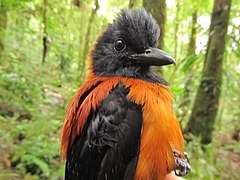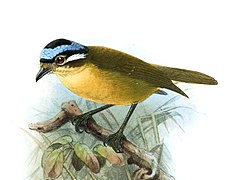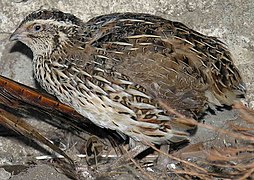Poison birds
Poisonous birds are birds that use various toxins ( poisonous substances ) for defense purposes. The birds do not synthesize these toxins themselves, but either ingest them with animal or vegetable food ( sequestration of toxins ) or rub them into themselves.
Known species
The two-color epitohui , the one- color epitohui , the blue-cap flute and the forest thick head use steroid alkaloids such as batrachotoxin , which are deposited in their skin and feathers. The African barnacle goose is poisonous because its tissues contain venom from the oil beetles that the barracked goose feeds on. It is also known that eating quail that has been shown to have toxins at certain times can cause coturnism . It is a human disease caused by muscle fiber breakdown and the consequences of rhabdomyolysis that occurs after eating quail that has fed on poisonous plants. The name is derived from the Latin name of the quail, Coturnix coturnix . The plague mentioned in the Bible, to which part of the people of Israel fell victim on their journey through the desert, was possibly this poisoning. It had collected and eaten the quail that had fallen from the sky.
Research history
The naturalist Hugh B. Cott first found evidence of toxins in birds while collecting and skinning birds in Egypt in 1941. He noticed that although hornets ate from a freshly skinned bird carcass of a palm pigeon , they did not touch the carcass of a gray fisherman lying next to it .
In 1992, while conducting field research on Raggi birds of paradise in the Variarata National Park in Papua New Guinea , John Dumbacher discovered that a species of bird widespread there, the Pitohui birds, contained a toxin in their feathers and muscle tissue. This toxin was identified as batrachotoxin , a steroid alkaloid previously only known from the skin of South American poison dart frogs of the genus Blattsteiger (Phyllobates).
Poisons and sources of poison
When examining the birds, various previously unknown congeners of batrochotoxin such as batrachotoxinin A-20R-cis-crotonate, batrachotoxinin-A-20R-3´-hydroxypentanoate, batrachotoxinin-A-20R-acetate and homobatrachotoxin were detected. The highest levels of batrachotoxin were found in the contour feathers of the belly, breast or legs of the birds, while lower amounts are found in the head, back, tail and wing feathers. The amount of poison varied between the different populations of Pitohui and Ifrita.
The birds take the batrachotoxins on from their food, especially from the toxic Melyridkäfer Choresine . When analyzing the stomach contents of Pitohui birds, choresine beetles, as well as numerous other small beetles and arthropods, were found. It is believed that the toxins are mainly used to ward off ectoparasites such as lice or against bacterial skin infections. In in vitro experiments, it was found that lice on Pitohui feathers are more likely to die than lice on non-toxic feathers. Pitohuis seem to be exposed to only a low tick load. Another study showed that the Pitohui have comparatively few blood parasites such as Plasmodia .
The toxins may serve to protect against predators such as snakes. The orange and black coloring of the two-color pitohui is probably aposematic and is mimicked by related birds such as P. kirhocephalus .
The spur geese are immune to the poison cantharidin , which they ingest from eaten oil beetles. This makes them poisonous to predators themselves. The quail venom is not yet known. It has long been suggested that the quail's toxic substance is coniin , a pseudo-alkaloid derived from piperidine found in plants such as the spotted hemlock . This has now been refuted. Coturnismus has been known since ancient times. The disease occurs mainly in Algeria , France , Greece and Russia . Quails are poisonous in Algeria and France in the spring during migration north. It is safe to eat when flying south in autumn. This pattern is reversed in Greece and Russia, where quail are poisonous on the southern autumn flight.
Web links
Individual evidence
- ↑ ( Num 11.31–34 EU )
- ↑ M. Tsironi: The patient with rhabdomyolysis: Have you Considered quail poisoning ?. In: Canadian Medical Association Journal. 171, 2004, pp. 325-326, doi: 10.1503 / cmaj.1031256 .
- ^ A b Paul J. Weldon: Avian chemical defense: toxic birds not of a feather. In: Proceedings of the National Academy of Sciences, 97, 2000, pp. 12948-12949.
- ^ John Tidwell: The intoxicating birds of New Guinea. In: ZooGoer. , Vol. 30, No. 2., 2001.
- ↑ JP Dumbacher, TF Spande, JW Daly: Batrachotoxin alkaloids from passerine birds: A second toxic bird genus (Ifrita kowaldi) from New Guinea. In: Proceedings of the National Academy of Sciences. 97, 2000, pp. 12970-12975, doi: 10.1073 / pnas.200346897 .
- ↑ John P. Dumbacher et al. a .: Melyrid beetles (Choresine): a putative source for the batrachotoxin alkaloids found in poison-dart frogs and toxic passerine birds. In: Proceedings of the National Academy of Sciences . 101, 2004, pp. 15857-15860; doi: 10.1073 / pnas.0407197101 .
- ↑ a b Dale H. Clayton et al. a .: How birds combat ectoparasites. In: The Open Ornithology Journal , 2010, pp. 41-71, doi: 10.2174 / 1874453201003010041 .
- ↑ Bruce W. Kennedy, Louis Evan Grivetti: Toxic quail: A cultural ‐ ecological investigation of coturnism. In: Ecology of Food and Nutrition. 9, 2010, pp. 15-41, doi: 10.1080 / 03670244.1980.9990580 .
- ^ David C. Lewis, Elizabeth Metallinos-Katzaras, Louis E. Grivetti: Coturnism: Human Poisoning By European Migratory Quail. In: Journal of Cultural Geography. 7, 1987, pp. 51-65, doi: 10.1080 / 08873638709478507 .







